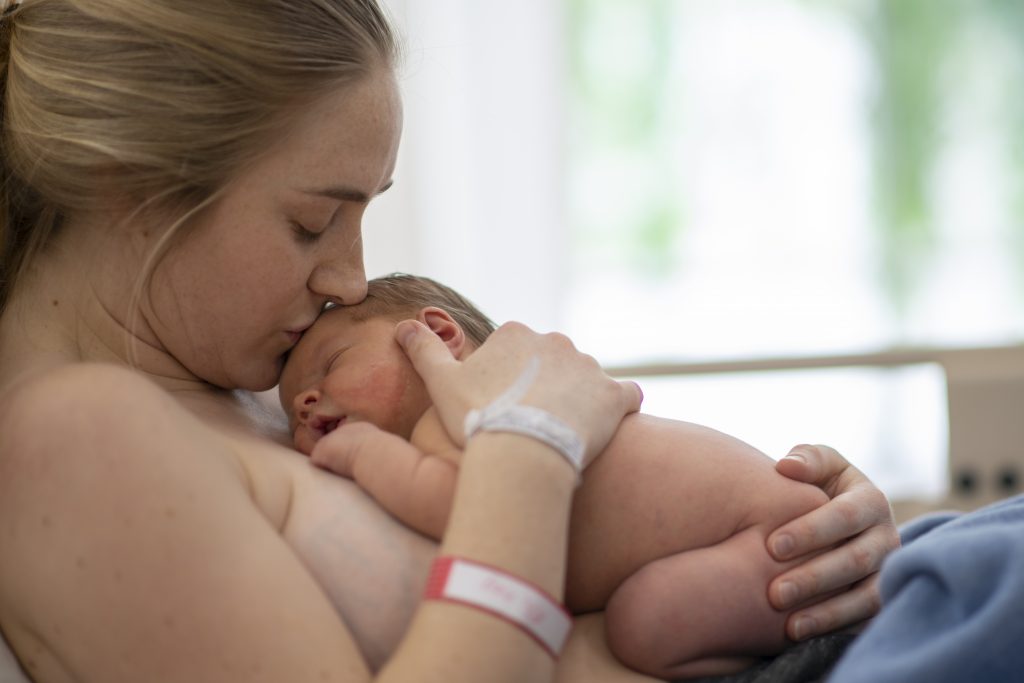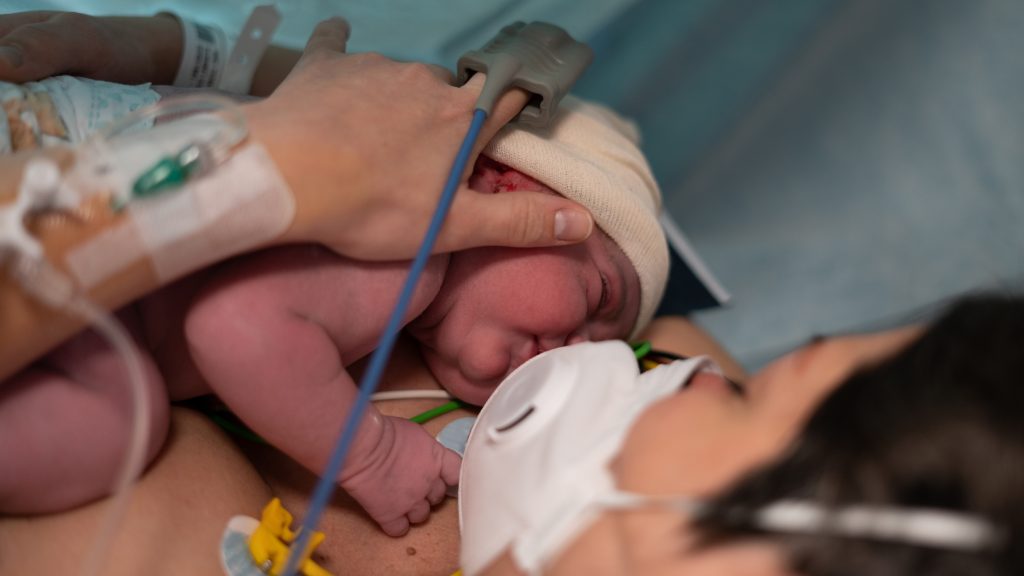If you’re currently pregnant and reading this, you will probably have heard some mention of the ‘first hour’ after birth and the term ‘skin-to-skin’. Standard practice in most Irish maternity hospitals, is to place a baby in skin-to-skin contact on its’ mothers’ chest immediately after birth. The HSE’s National Infant Policy states that “2.7.20 All mothers and their babies should have unhurried SSC immediately following the birth and it should be continued uninterrupted for at least 60 minutes.”

But have you ever wondered why this first hour of uninterrupted skin-to-skin contact between mother and baby is so important? And why there has been such a strong push internationally and nationally to implement and protect this first hour? In a nutshell, research that has been conducted over the last 40 years has found that undisturbed skin-to-skin contact after birth keeps baby calm, promotes bonding and improves breastfeeding initiation and duration rates (Moberg, K.U. 2019). Studies have even found that newborns in skin-to-skin contact showed enhanced neuro-physical development and reduced pain (Gray, Watt and Blass, 2000). So for a baby who has been born via a difficult instrumental delivery, immediate skin-to-skin contact with his mother may be even more important.
Newborn babies are little mammals. They are entirely helpless when they are born, but they do come with a strong survival instinct and innate behaviours and reflexes that help them find their mother’s breast when they are placed skin-to-skin with her immediately after birth. It’s as if they are born with a pre-programmed micro-chip which has all the instructions for what to do to get to the breast and feed. While in utero babies learn the skills they need to breastfeed (eg swallowing and sucking). And placing the baby on its’ mother’s abdomen after birth creates the optimal conditions for the baby to use these skills and successfully breastfeed. The mother’s body is a familiar place for the baby. The baby recognises the mother’s smell, her familiar heartbeat and her rhythm of her breath. And all of this calms and soothes baby, and helps to ease his transition from womb to the world. The mother’s body is this little mammals’ natural habitat and the place where he feels safe.
And some pretty amazing things happen on a physiological level when baby is in skin-to-skin contact with his mother. Baby’s heart rate, breathing, body temperature, blood glucose level and blood pressure become stable. And baby is far less likely to cry. Skin-to-skin also supports optimal brain development as it causes nerve impulses to be sent to the brain which activate the limbic brain and the prefrontal-orbital pathway.
According to a 2001 study,
“The dyadic interaction between the newborn and the mother constantly controls and modulates the newborn’s exposure to environmental stimuli and thereby serves as a regulator of the individual’s internal homeostasis.”
From the baby’s perspective, separation is life threatening and results in crying and elevated stress levels.
Skin-to-skin also has benefits for the mother as it enhances the flow of oxytocin, often referred to the ‘love’ hormone. Oxytocin contracts the uterus and reduces post-partum haemorrhage, triggers the ‘letdown’ reflex which releases colostrum/milk, and increases mothering behaviours, bonding, facial recognition, relaxation and attraction to the newborn.
“Mothers who hold their newborns skin-to-skin after birth have increased maternal behaviours, show more confidence in caring for their babies and breastfeed for longer durations.” (Philips, 2013). And mothers who provide skin-to-skin contact for their infants report less depression and more empowerment in their parenting role (Johnson, A.E., 2007).
So back to breastfeeding. Facilitating immediate skin-to-skin in the immediate postpartum period improves breastfeeding initiation rates (Lau, Tha, Ho‐Lim et al., 2018). It doesn’t guarantee that you and your baby will be able to initiate breastfeeding without any problems. But it certainly optimises your chances of getting off to a good start. Recent research has found that newborn babies go through 9 instinctive stages after they are born and placed in skin-to-skin contact with their mothers. The first stage is the birth cry. Then after a little rest, baby’s natural instincts to find the breast will kick in. It will start to move its’ hands, shoulders, feet and head, all in an effort to wriggle closer to the breast. This is known as the ‘breast crawl’ and it was first observed by Swedish researchers in the 1980s. As your baby moves towards your breast, he will also be drawn to the smell of your milk and to the sight of your darkened areola (it darkens during pregnancy for a reason!). Eventually, with a little help and support, and patience, your baby will wriggle towards the breast, latch on and suck. There are more details about the individual stages here.
Try to be patient with your baby. Give him time to adjust to being in the world. Give him time to explore your body and find your breast. It might take an hour or two before he starts to suck. So avoid trying to rush him – pushing him to the breast could upset or confuse him. Give him a chance to adjust to his new surroundings and to initiate breastfeeding himself. Trust that your baby knows what to do. Also, try to avoid interrupting this special time – weighing, cleaning and checks by hospital staff can wait until after your baby has had his first feed. Remember that the HSE policy states that the first hour should be UNINTERRUPTED (assuming baby is physiologically stable and that there are no concerns for his health).
Enjoy the first hour – make it a gentle welcome to the world for your baby.
If your baby doesn’t feed within the first hour or two (sometimes babies can be a little sleepy), don’t hesitate to ask for help. You may need to hand express some colostrum and feed it to your baby in a syringe or cup until he is ready to feed at the breast. Your baby will need just a tiny amount as his tummy has a capacity of only 5ml at birth. So every drop counts.

In the event that you have a caesarean birth, skin-to-skin should still be possible (Maria, A. et al. 2018). If you are having a scheduled c-section, the facilitation of skin-to-skin is something you can discuss with your obstetrician or midwife. If skin-to-skin can’t be facilitated, e.g. if you are unwell or your baby needs to go to the baby unit, the next best thing is for baby to be placed in skin-to-skin contact with your partner until you are ready to hold him. If separation is unavoidable, don’t worry because you can make up this time later – your baby retains the newborn instincts and reflexes for a couple of months after birth, so even if your baby has spent time in ICU it is not too late to do skin-to-skin. You and your baby can benefit from skin-to-skin at any time. Just have a listen to what leading expect on skin-to-skin Nils Bergman says about it (914) Skin to Skin Contact – YouTube.
- Bigelow, A. E. and Power, M. (2012) ‘The effect of mother–infant skin-to-skin contact on infants’ response to the Still Face Task from newborn to three months of age’, Infant behavior & development, 35(2), pp. 240-251.
- Bigelow, A. E. et al. (2018) ‘Mother–infant skin‐to‐skin contact and mother–child interaction 9 years later’, Social development (Oxford, England), 27(4), pp. 937-951.
- Gray, L., Watt, L. and Blass, E. M. (2000) ‘Skin-to-Skin Contact Is Analgesic in Healthy Newborns’, Pediatrics (Evanston), 105(1), pp. e14-e14.
- Johnson, A. N. (2007) ‘The maternal experience of kangaroo holding’, Journal of Obstetric, Gynecologic & Neonatal Nursing, 36(6), pp. 568-573.
- Lau, Y. et al. (2018) ‘An analysis of the effects of intrapartum factors, neonatal characteristics, and skin‐to‐skin contact on early breastfeeding initiation’, Maternal and child nutrition, 14(1), pp. e12492-n/a.
- Maria, A. et al. (2018) ‘Achieving Early Mother-baby Skin-to-skin Contact in Caesarean Section: A Quality Improvement Initiative’, Indian pediatrics, 55(9), pp. 765-767.
- Moberg, K.U., (2010), Why Oxytocin Matters. Pinter and Martin.
- Moberg, K. U., Handlin, L. and Petersson, M. (2020) ‘Neuroendocrine mechanisms involved in the physiological effects caused by skin-to-skin contact – With a particular focus on the oxytocinergic system’, Infant behavior & development, 61, pp. 101482.
- Moore, E. R. et al. (2012) ‘Early skin-to-skin contact for mothers and their healthy newborn infants’, Cochrane database of systematic reviews, 5(5), pp. CD003519-CD003519.
- Phillips, R. (2013) ‘The Sacred Hour: Uninterrupted Skin-to-Skin Contact Immediately After Birth’, Newborn and infant nursing reviews, 13(2), pp. 67-72.
- Vittner, D. et al. (2018) ‘Increase in Oxytocin From Skin-to-Skin Contact Enhances Development of Parent–Infant Relationship’, Biological research for nursing, 20(1), pp. 54-62.
- Widström, A. M. et al. (2019) ‘Skin‐to‐skin contact the first hour after birth, underlying implications and clinical practice’, Acta Paediatrica, 108(7), pp. 1192-1204.
- HSE National Infant Feeding Policy 2019 Microsoft Word – Infant Feeding Policy for Maternity Neonatal Services .doc (hse.ie)
Perfect i loved the post this is new to me i’m from Brazil, but i translated the text and loved it.
Congratulations on the site, also know mine:
https://strelato.com
.